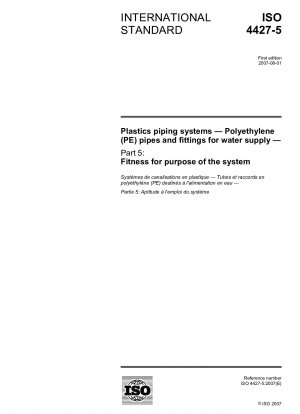ISO 4427-5:2007
Plastics piping systems - Polyethylene (PE) pipes and fittings for water supply - Part 5: Fitness for purpose of the system
- Standard No.
- ISO 4427-5:2007
- Release Date
- 2007
- Published By
- International Organization for Standardization (ISO)
- Status
- Replace By
- ISO 4427-5:2019
- Latest
- ISO 4427-5:2019
- Scope
- This part of ISO 4427 specifies the characteristics of the fitness for purpose of assembled piping systems made from polyethylene (PE) intended for the conveyance of water for human consumption, including raw water prior to treatment and water for general purposes. It also specifies the test parameters for the test methods to which it refers. In conjunction with the other parts of ISO 4427, it is applicable to PE pipes, fittings, valves, their joints and to joints with components of other materials, intended to be used under the following conditions: a) a maximum operating pressure (MOP) up to and including 25 bar1); b) an operating temperature of 20 °C as the reference temperature. NOTE 1 For applications operating at constant temperatures greater than 20 °C and up to 40 °C, see ISO 4427-1:2007, Annex A. NOTE 2 ISO 4427 covers a range of maximum operating pressures and gives requirements concerning colours and additives. It is the responsibility of the purchaser or specifier to make the appropriate selections from these aspects, taking into account their particular requirements and any relevant national guidance or regulations and installation practices or codes.
ISO 4427-5:2007 Referenced Document
- ISO 11413:1996 Plastics pipes and fittings - Preparation of test piece assemblies between a polyethylene (PE) pipe and an electrofusion fitting
- ISO 11414:1996 Plastics pipes and fittings - Preparation of polyethylene (PE) pipe/pipe or pipe/fitting test piece assemblies by butt fusion
- ISO 1167-1 Thermoplastics pipes, fittings and assemblies for the conveyance of fluids - Determination of the resistance to internal pressure - Part 1: General method
- ISO 1167-3 Thermoplastics pipes, fittings and assemblies for the conveyance of fluids - Determination of the resistance to internal pressure - Part 3: Preparation of components*, 2007-11-01 Update
- ISO 13953 Polyethylene (PE) pipes and fittings — Determination of the tensile strength and failure mode of test pieces from a butt-fused joint — Amendment 1*, 2020-04-20 Update
- ISO 13954 Plastics pipes and fittings — Peel decohesion test for polyethylene (PE) electrofusion assemblies of nominal outside diameter greater than or equal to 90 mm — Amendment 1*, 2020-04-20 Update
- ISO 13955 Plastics pipes and fittings — Crushing decohesion test for polyethylene (PE) electrofusion assemblies — Amendment 1*, 2020-04-20 Update
- ISO 3458 Plastics piping systems - Mechanical joints between fittings and pressure pipes - Test method for leaktightness under internal pressure*, 2015-04-01 Update
- ISO 3459 Plastic piping systems — Mechanical joints between fittings and pressure pipes — Test method for leaktightness under negative pressure*, 2022-03-29 Update
- ISO 3501 Plastics piping systems — Mechanical joints between fittings and pressure pipes — Test method for resistance to pull-out under constant longitudinal force*, 2021-12-14 Update
- ISO 3503 Plastics piping systems - Mechanical joints between fittings and pressure pipes - Test method for leaktightness under internal pressure of assemblies subjected to bending*, 2015-03-01 Update
- ISO 4427-1:2007 Plastics piping systems - Polyethylene (PE) pipes and fittings for water supply - Part 1: General
- ISO 4427-3 Plastics piping systems — Polyethylene (PE) pipes and fittings for water supply — Part 3: Fittings*, 2019-08-06 Update
ISO 4427-5:2007 history
- 2019 ISO 4427-5:2019 Plastics piping systems — Polyethylene (PE) pipes and fittings for water supply — Part 5: Fitness for purpose of the system
- 2007 ISO 4427-5:2007 Plastics piping systems - Polyethylene (PE) pipes and fittings for water supply - Part 5: Fitness for purpose of the system
